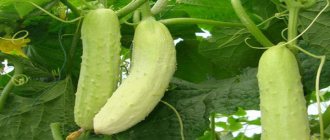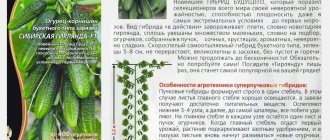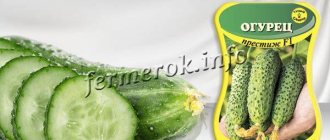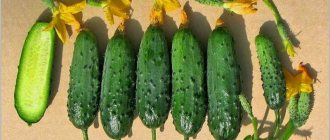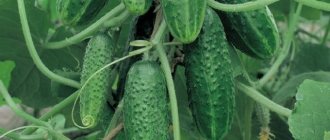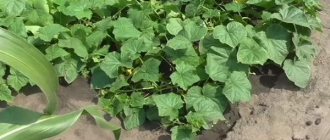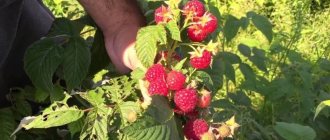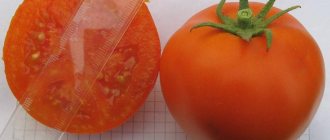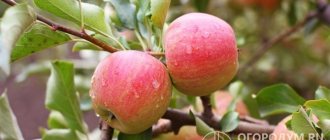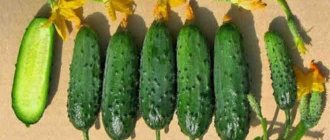Vegetable growing » Cucumbers
0
1448
Article rating
Kira Stoletova
Cucumber is one of the most popular vegetable crops, but choosing seeds for planting is not so easy even for experienced farmers. The Pasamonte cucumber has a hybrid origin, which allows it to be grown even in unfavorable conditions.
Characteristics of Pasamonte cucumber
The species has good resistance to drought and various diseases. The fruits have a good presentation and pronounced taste.
Description of the variety
“Pasamonte” is a cucumber variety that does not require additional pollination (parthenocarpic), early ripening. After the first shoots appear, it will take about 35 days before harvesting.
The plants are medium-climbing, with at least 2 ovaries formed in each node. A high level of parthenocarpy contributes to increased fruit set in cucumbers. The bushes are medium-sized, well-leafed with large green and light green leaves.
The hybrid has good disease resistance.
The length of cucumbers is 6-10 centimeters, and their weight is 60-120 grams. The vegetables have a cylindrical shape, the ratio of length to width is 3 to 1. The surface of the fruit is coarsely tuberous, the skin is dark green. Spots and white stripes reaching the middle of the vegetable are allowed. The cucumber pulp is crispy, dense, there is no bitterness or voids.
The hybrid is distinguished by excellent taste, stable yield, and resistance to overgrowth and disease. A universal variety, consumed fresh, and also suitable for pickling and pickling.
Description of the hybrid
The Dutch hybrid Pasamonte f1 was bred by breeders of the Syngenta seeds company and included in the State Register of Russia in 1997. Approved for cultivation in the Central and Middle Volga regions in open and closed ground.
Plants are medium-sized, medium-climbing. 2-3 greens are formed in one node. The fruits are not prone to overgrowth.
The hybrid belongs to parthenocarpics - plants with a female type of flowering. Male flowers do not take part in fertilization.
Pictured are Pasamonte cucumbers.
Distinctive features
The characteristics of the hybrid are collected in the table.
| Indicators | Characteristic |
| Ripening period | Early ripening, harvested 40–43 days after germination |
| Pollination type | Parthenocarpic |
| Weight | 67–120 g |
| Length | 6–9 cm |
| Form | Cylindrical, medium ribbed |
| Coloring | Emerald green with dark green longitudinal stripes and medium spotting |
| Leaves | Lightly corrugated, medium to large, light green to green in color |
| Pulp | Crispy, refreshing, not watery, virtually seedless |
| Taste | Without bitterness |
| Skin | Thin, coarsely tuberous, with white spines |
| Purpose | Universal |
| Productivity | 269–329 c/ha |
| Sustainability | To brown spot, cucumber mosaic |
| Transportability | High |
Composition and KBJU
Nutritional value of cucumbers (per 100 g):
- calorie content – 14 kcal;
- proteins – 0.8 g;
- fats – 0.1 g;
- carbohydrates – 2.5 g;
- water – 95 g;
- fiber – 1 g.
Cucumbers are a storehouse of vitamins and minerals:
- vitamin A;
- beta-carotene;
- vitamins B1, B2, B4, B5, B6, B9;
- vitamin C;
- vitamin E;
- vitamin H;
- vitamin K;
- vitamin PP;
- potassium;
- calcium;
- silicon;
- magnesium;
- sodium;
- sulfur;
- phosphorus;
- chlorine;
- iron;
- iodine;
- manganese;
- copper;
- selenium;
- fluorine;
- chromium;
- zinc.
Benefit
Thanks to their rich composition, cucumbers have many beneficial properties:
- remove salts;
- improve metabolism;
- remove free radicals;
- dilate blood vessels and capillaries;
- normalize blood pressure;
- remove “bad” cholesterol;
- dissolve sand and kidney stones;
- stimulate insulin production;
- eliminate bad breath;
- improve the properties and composition of blood.
Ripening time
"Pasamonte" is an early ripening hybrid. The period from the appearance of the first shoots to the beginning of fruiting is quite short - about 40 days.
The ripening process can be accelerated a little by properly caring for the planted plant. Thus, climatic conditions, air humidity, and fertilizing have a great influence.
Care
Agricultural cultivation technology involves basic procedures:
- Formation into one stem, including partial pinching and removal of leaves below the 3rd node. At the upper level of growth, the stepsons break off at a length of 30-50 cm, at the middle level - at 20-30 cm. They begin to form bushes from the 10th day after planting, when rooting occurs;
- Garter to the trellis on 3 levels. After the growth shoot is fixed on the top crossbar, it is pinched;
- Moderate daily watering in hot weather, 1-2 days later in cool weather. For irrigation use settled warm water. When irrigating, avoid getting water on the green parts of plants;
- Complex fertilizing - 3-5 times per season. A solution of mullein or manure, as well as mineral complexes with a predominance of nitrogen, are used as fertilizers. Fertilizers are applied only after abundant watering.
Planting and care
“Pasamonte” cucumbers are planted in unheated greenhouses or in open ground at the end of May or at the beginning of June, at night temperatures not lower than 15 C.
It is necessary to collect fruits regularly - at least twice a week.
Priming
To grow vegetables, choose well-lit, sun-warmed areas with fertile soil. You can sow the seeds yourself or use the seedling method.
The soil for planting is first dug up, manure and mineral fertilizers are added.
Sowing
Seedlings for planting should be 25-35 days old and have several leaves. The sowing density is no more than 3-5 bushes per square meter, the sowing depth is one and a half to two centimeters.
When planting seeds, they must first be soaked for a day in a solution of vermicompost, and also warmed up.
At first, planted cucumbers need to be protected from nighttime drops in temperature using film cover. The film can be replaced by any other non-woven material that is highly permeable to air, water and light, but protects against cold weather.
It is recommended to grow "Pasamonte" using vertical tying.
Watering
Caring for a hybrid grown in open ground includes:
- Feeding. Mineral fertilizers or fresh manure are used for fertilizing. A bucket of water will require 10 g of urea or a liter of manure. Feeding is carried out exclusively in the evening, 3-4 times a month.
- Watering. Before the plants bloom, it is enough to water them weekly. At the fruiting stage, the beds need to be watered once every 2-3 days, and during the hot period - daily or every other day. Water for irrigation should be warm.
- Weeding and loosening. To improve the aeration parameters of the soil, it is necessary to weed the plants daily and then carefully loosen the soil.
How to grow a hybrid yourself
Pasamonte cucumbers are grown through seedlings and sowing in open ground. Caring for the crop is standard and requires compliance with the watering and fertilizing schedule, loosening and weeding of the area.
Planting by seedlings
The seedling method of growing cucumbers significantly reduces the ripening time. Even in open ground, the harvest begins two weeks earlier compared to cucumbers grown in a greenhouse using direct sowing.
Hybrid seeds do not require pre-sowing disinfection or soaking with growth stimulants. The seed material is processed in production.
To grow strong and healthy seedlings, use nutritious soil: 1 part sawdust, 2 parts peat and humus. Add 2 tbsp to a 10 liter bucket. l. ash and 1.5 tbsp. l. nitrophoska.
The mixture is thoroughly mixed and distributed into plastic or peat containers to the top. Seeds are planted to a depth of 1-2 cm, 1 piece each. into each container and water with warm, settled water.
At the stage of 2-3 true leaves, seedlings are fed with a nutrient solution: 3 tsp. nitrophoska (nitroammofoski) per 3 liters of warm water. Seedlings need to be watered abundantly, once every seven days.
After 27–32 days, the seedlings will be ready to “relocate” to a permanent location.
Holes with a depth of 10-15 cm are formed on the site, boiling water is poured over it and seedlings are planted at a distance of 50–60 cm.
Direct sowing into soil
Cucumbers are hypersensitive to cold, so for rapid germination the soil must warm up to at least +14 °C, and the air - up to +22 °C. The best time for sowing is the last ten days of May. The culture prefers light and nutritious soil from a mixture of turf, sawdust, humus and peat (1:1:1:1).
The site for sowing is chosen on the south side. The soil is dug up before winter, fertilized with humus and watered with a solution of copper sulfate (1 tsp per 3 liters of water). The seeds are planted with the narrow part down, 2 pieces at a time, to a depth of 2-3 cm with an interval of 10 cm. Next, the soil is watered generously with warm, settled water.
The area is covered with polyethylene or agrofibre to protect it from night frosts. The seeds hatch in 6–8 days.
Important! When planting, the main principle of crop rotation is observed - do not grow cucumbers in the same place year after year.
Growing and care
It is not advisable to cultivate cucumber crops near plantings of tomatoes, radishes and radishes. Healthy neighbors are dill, beans, peas, garlic, cabbage, beets, and onions.
Basic rules for successful cucumber farming:
- Loosening the beds after each watering and removing weeds. The procedure is carried out carefully, trying not to catch the roots located close to the surface of the earth.
- Mulching the soil with sawdust or peat will help reduce the amount of weeding.
- Before flowering, moderate watering is provided - once every 7 days. During the fruiting period, plants are watered at the root daily.
- Pruning of the vines is carried out during the period of rapid growth, forming the plant into one stem.
- The culture is responsive to regular feeding. In total, 4-5 portions of fertilizer are applied during the growing season.
Scheme for feeding cucumbers:
- before flowering – 1 tsp. urea and superphosphate, 1 tbsp. l. sodium humate per 10 l;
- during the fruiting period - 1 tbsp. l. nitrophoska, 20 g of chicken manure per 10 liters of water;
- subsequent feedings (every two weeks) – 1 tsp. potassium sulfate, 500 ml mullein per 10 liters of water.
Instead of fertilizers prepared independently, they use ready-made humic fertilizers “Breadwinner”, “Ideal”, “Fertility”.
Features of cultivation and possible difficulties
The agricultural technology of Pasamonte cucumbers does not differ significantly from the cultivation of other hybrids.
Vigorous plants require vertical tying to a trellis.
Cucumbers are planted behind curtain crops (sunflowers, corn) for protection from cold winds and scorching sun rays. Tall crops act as a kind of wall, behind which cucumbers feel comfortable and begin to bear fruit several days earlier.
Reference. Wing crops are sown perpendicular to the direction of the dominant winds 6–10 days before sowing or planting cucumbers.
Diseases and pests
The hybrid is immune to brown spot and cucumber mosaic and is absolutely immune to bacteriosis, powdery mildew, and gray rot of roots.
Treatment of plants with chemicals delays the fruiting of the crop. In the fight against fungi and bacteria, prevention and treatment with organic and mineral compounds are effective.
Signs of powdery mildew:
- white-yellow coating on stems and leaves;
- small brown balls (spores);
- drops of dew on greenery;
- dry leaves, curled upward;
- rot on cucumbers.
Treatment:
- A liter of curdled milk, whey or kefir per 10 liters of water. The number of treatments is not limited.
- Per liter of water 1/3 tsp. soda ash, 25 ml of liquid soap. Treat once every seven days.
- A liter jar of wood ash for 5 liters of boiling water. Leave for 24 hours, spray the bushes once every seven days.
Signs of gray rot:
- gray-brown slippery spots on stems and leaves;
- gray, indefinitely shaped spots on fruits;
- the appearance of watery gray fluff on the fruit.
For safe treatment, use the Trichodermin suspension. For irrigation, 100 ml of the drug is diluted in 10 liters. In case of severe damage, plants are treated up to 5 times a week. To prevent gray rot, before planting in the ground, the roots are dipped in a mixture of 5 liters of water, two parts of soil, one part of humus, 5 g of suspension. After two leaves appear, the seedlings are treated every two weeks.
Signs of bacteriosis:
- yellow-brown spots on cotyledon leaves with a characteristic angular shape;
- mucus from the back of the leaves;
- leaf perforation.
Treatment:
- Infuse 100 g of onion peels in 1 liter of boiling water. After 48 hours, strain the solution and dilute with water in a ratio of 1:5. Treat bushes once every 10 days after sunset.
- For 10 liters of water 1 tsp. boric alcohol and brilliant green, spray the plants once every 20 days.
Disease prevention measures:
- periodic treatment with Trichopolum (2 tablets per 1 liter of water);
- moisture level control;
- compliance with crop rotation;
- removing wilted and dry leaves;
- removing 3–5 cm of soil and removing plant debris at the end of the season;
- timely feeding;
- loosening the soil;
- choosing a sunny place for planting;
- treatment of the plot with "Gamair" before sowing;
- reduction of nitrogen in the soil;
- thinning of plantings.
Spider mites and slugs pose a particular danger to cucumbers. For prevention, the soil is dug up in the fall and left to freeze.
Folk remedies against spider mites:
- grind 1 kg of aloe vera through a meat grinder, pour in 10 liters of water and mix in 50 g of laundry soap shavings;
- pour 300 g of horse sorrel into 10 liters of water, leave for 3–5 hours;
- Pour 50 g of greens and dandelion flowers into 2 liters of water and leave for 3-4 hours.
Processing frequency is once every two weeks.
Folk remedies against slugs:
- Mix equal parts ground black pepper, wood ash and rock salt. Sprinkle the mixture into the beds and loosen.
- Dig furrows around the perimeter of the beds and pour ash and tobacco dust into them in equal parts.
- Mulch the soil with crushed eggshells, pine needles, sawdust, and river sand. Slugs do not like to crawl on such surfaces; sharp particles cut their abdomen.
- Prepare a solution of 1 liter of water and 2 tbsp. l. ammonia. Spray the bushes at night.
Pests and diseases
The hybrid has a high degree of protection against cladosporiosis, is resistant to powdery mildew, cucumber mosaic virus, and downy mildew.
Diseases to which the variety is susceptible:
- root rot;
- anthracnose (scarden);
- gray rot;
- sclerotonia (white rot).
Cucumbers of the Pasamonte variety will appeal to the following pests:
- slugs;
- whiteflies;
- root-knot nematodes;
- wireworms;
- mole crickets;
- thrips.
Pros and cons of the variety
- The Pasamonte cucumber variety has the following positive qualities:
- resistant to major diseases characteristic of vegetable crops;
- the fruits do not outgrow;
- the variety does not require pollination;
- excellent nutritional characteristics;
- universal use, especially suitable for pickling;
- long fruiting;
- does not require care;
- good presentation.
- Disadvantages include:
- susceptibility to downy mildew and bacteriosis;
- the need to fix the plant to a support.
Collection and storage
It is extremely important to harvest on time. Overgrowth reduces the quality of cucumbers and shortens the fruiting period. The first harvest can be harvested within 35 days after the first shoots appear. By this time, cucumbers reach a size of 7-9 cm. In open ground, this period may increase.
"Pasamonte" has a fairly long shelf life - 10 days without loss of cucumber quality. For those who grow vegetables for sale, this property is very valuable. You can store cucumbers in the refrigerator, in water or any cool, dry place.
Sowing and agrotechnics of cultivation
The Pasamonte variety is intended for planting in open ground or in greenhouses, using seedlings or directly with seeds. The main requirements for optimal cultivation of cucumbers are:
- loose, light soil, rich in nutrients, loamy or sandy loam, without stagnant water;
- night air temperature should not be lower than +15°C;
- the predecessors of cucumbers in the garden can be: potatoes, tomatoes, cabbage, legumes;
- the land is cleared of debris and weeds in advance (preferably before winter), deeply dug up, fertilized with manure (6–9 kg per 1 m²), wood ash (200 g per 1 m²) or mineral fertilizers.
Did you know? Cucumber
“discovered”
more than 6 thousand years ago, and its homeland is India and the Himalayas.
To grow seedlings you need:
- disinfect the seeds in a weak solution of potassium permanganate (25–30 minutes);
- rinse the seed with water and soak, wrapped in a moistened napkin for 1 day;
- to speed up germination, you can use a growth stimulator;
- harden the seeds by placing them on the bottom shelf of the refrigerator for two days;
- you can plant the seeds in separate containers (peat glass, tablet) for convenient replanting in the ground;
- Seedlings should germinate at a temperature of +27°C; after the first leaves appear, reduce the temperature to +21…+23°C;
- seedlings can be transplanted into the ground after 3–5 true leaves appear, having previously hardened it for 7 days in a cooler room or outdoors.
If the seeds are sown directly into the ground, then it is also advisable to germinate them, harden them and plant them in well-warmed soil (+15°C)
In the open ground
The Pasamonte variety is planted in the garden in the second half of May, when the air temperature rises to +17°C at night and to +20°C during the day. The place should be bright, sunny, windless. The scheme for sowing or planting in a garden bed is that it is recommended to plant from 3 to 4 plants per 1 m², the sowing depth is 1.5–2 cm.
In the greenhouse
The scheme for planting cucumbers in greenhouses is that you need to leave a distance of 30–35 cm between the bushes, and 60 cm between the rows. The room temperature should not be lower than +15°C. The greenhouse should be well ventilated, but there should be no drafts. The land for planting must be prepared in advance: dug up and fertilized.
Video: planting cucumbers in a greenhouse
Advantages and disadvantages of the variety
Hybrid cucumbers have many advantages, thanks to which gardeners love them:
- have excellent taste, not bitter;
- have a remarkable marketable appearance, uniform green color;
- universal: suitable for fresh consumption (in salads), salting and pickling;
- not susceptible to many cucumber diseases;
- stable yield;
- do not have a tendency to outgrow;
- early ripeness;
- self-pollinating, no need for insects;
- can be grown to produce gherkins.
A significant disadvantage of the hybrid is incomplete resistance to disease. When growing cucumbers, the gardener has to carry out additional manipulations and carefully process the plants.
Today, Pasamonte cucumbers are produced in Russia by various agricultural companies. The appearance and characteristics of such fruits differ from the original produced by the Scottish company.
Many gardeners choose Pasamonte seeds for sowing, which give a stable harvest of delicious fruits.
Landing
The crop is grown through seedlings and direct sowing on the site. The bushes are planted at a distance of 30 cm. 60-70 cm are left between the rows.
Site requirements:
- illumination;
- loose fertile soil with neutral pH;
- no drafts.
Seedlings are transplanted into unheated beds when the outside temperature is 20-24 degrees and the soil temperature is within 12-14 degrees.
Planting density is 3-4 bushes per 1 m2.
Diseases and pests
Seeds of hybrid origin have good resistance to fungal and bacterial diseases. However, preventive actions ultimately minimize the risk of plant disease.
Early ripeness does not allow spraying the vines with potent chemicals, as this can lead to toxicity of the greens. To prevent diseases, it is better to use mixtures based on organic and mineral components:
- Powdery mildew is vulnerable to a solution in milk with the addition of iodine and soap. The leaves of the bushes should be treated with this liquid.
- To prevent gray rot of roots, use water with the addition of baking soda.
- Bacteriosis will not affect bushes treated with Trichopolum. 2 tablets of the drug are diluted per 1 liter of water.
The description says that when growing vegetables in open ground, there is a high risk of losing part of the harvest due to pests. Spider mites and slugs are especially dangerous for crops. To destroy harmful insects, you need to dig up the area in the fall and leave it to freeze.
Cucumber “Pasamonte F1”: description, reviews, characteristics
One of the most popular vegetables in our country is cucumber. Let’s take a closer look at one of the interesting varieties, namely the Pasamonte F1 cucumber, consider its brief description and provide reviews from avid gardeners.
General information
Pasamonte cucumbers are high-yielding hybrids. Judging by the observations of many gardeners, their ripening period is quite short. This hybrid was selected by an agrotechnical company (Syngenta Seeds BV), located in Holland. Already in 1997, the seeds were included in the state register of two regions of our country: Central and Middle Volga.
“Pasamonte F1” cucumbers can be sown both in open ground and in greenhouse conditions (or under an awning or film). The list of recommendations includes planting on personal and garden plots, as well as on small farms.
This seed variety is parthenocarpic, i.e. self-pollinating. The type of greens is gherkin. The growing season is no more than 43 days, after which the harvest can be harvested. The bush of the plant is quite strong, the branching is not very developed, and the ripeness is moderate.
The leaves of the bush are slightly corrugated, small (usually medium) in size. The color is green or light green, without rich tones. One leaf axil can reproduce up to three ovaries. The increased qualities of parthenocarpy allow “Pasamonte” to form a larger number of ovaries.
The fruit has mild ribbing and a cylindrical shape. There are small tubercles on the surface. The length of the greens is up to 9 cm, weight – from 80 to 110 g. The covering of the fruit is a rich emerald green color, there are spots and white stripes that reach approximately the middle part of the green.
There are also white spikes on the surface. Pasamonte F1 seeds are small in size, even compared to other varieties. The taste of the hybrid is assessed as high. The pulp is dense, not watery, crispy, and has a pleasant refreshing taste. Bitterness is absent in all cases, thanks to selection.
Cucumber variety "Pasamonte F1" has high yields. From one hectare you can collect up to 330 quintals.
If you grow “Pasamonte F1” for sale, then the commercial output will be at least 95%, and this is a very good indicator.
Features of the variety
If you look at the characteristics of this hybrid, you can find out that it belongs to varieties of universal use. Although, if you believe reviews from gardeners, Pasamonte is inferior in taste to varieties intended for salads. But the taste of greens is perfectly revealed when canned.
The variety is very susceptible to both downy mildew and bacteriosis. But the plant does not have a tendency to overgrow the fruits (growth automatically slows down when the green stage begins). It has increased resistance to the main diseases inherent in this variety - spotting (brown), cucumber mosaic.
Pasamonte cucumbers are produced by many domestic agricultural companies and are distributed throughout the central part of Russia. Variety characteristics may vary depending on the manufacturer.
Main advantages
This hybrid has many more advantages than disadvantages. Below is a list of the main advantages of cucumbers:
- Quite high resistance to several types of diseases.
- Parthenocarpic variety, does not depend on pollinating insects.
- Early and very high yield.
- The lack of bitterness is due to a genetic factor.
- A wonderful fruit with optimal proportions and bright taste.
- Can be grown to produce gherkins.
- Universal use: for pickling, in salads, canning, eating fresh directly from the garden.
- Another genetic condition: slower growth after the transition to the green stage. When the fruit reaches its optimal size, it practically does not change until the harvesting stage, it is only fed with everything necessary.
It is worth remembering that resistance is not available to all diseases, so to exclude them it is necessary to carry out appropriate treatment.
There is only one significant drawback: incomplete resistance to disease. This leads to the fact that the gardener needs to resort to additional manipulations, carry out appropriate treatment of the plant, etc.
Reviews
“I purchased Pasamonte seeds by accident last year. As a result, it bears fruit until October. A very good variety, does not taste bitter, does not require special care. Although they write that he is not immune to all diseases, I was fine and didn’t get sick with anything. I’ll definitely plant it next year.” Vitaly, 36 years old, Saransk. “I help my parents in the garden.
This summer I decided to start growing cucumbers myself. We went to the store and bought several varieties of seeds, including Pasamonte. When I went online, I found out that the cucumbers themselves may differ depending on the manufacturer. I was a little upset because... Our company was Russian, and these cucumbers come from Holland. But there is nothing to do, I planted what I had.
As a result, when the first harvest appeared, I compared the photos of the Dutch ones, and they were practically no different from those that grew in our garden.” Maria, 22 years old, Kstovo. “I am an experienced gardener, and I know roughly what to expect from this or that variety of cucumbers. I am wary of hybrids; you never know what will happen in the end.
I try to give preference to traditional varieties that were bred in our region and zoned for it. Until this summer, everything was like that, but my daughter brought me several packages of Pasamonte to try, asking me to test them in action. I decided to experiment and grew a crop of this hybrid. To be honest, I was pleasantly surprised.
Fruiting stopped only with the onset of night frosts, it did not require any special care, and did not get sick (although I always take care of my plants). As a result, my attitude towards hybrids has changed. Of course, I’m not going to give up my favorite varieties, but I’ve already prepared a bed for “Pasamonte” for next spring. Let it grow, I will compare further.”
Nadezhda Semenovna, 58 years old, Ivanovo. “I became interested in growing vegetables on my plot. I think, like many, I decided to try Pasamonte among other varieties. This hybrid turned out to be one of those that has proven itself well. Now I recommend it to everyone, both friends and at work.
One trouble happened - they started to get sick, but this is a plus, I think, at the same time I learned how to care for the bush, no big deal, in principle. Overall, I recommend it!” Oscar, 34 years old, Suzdal.
Conclusion
We reviewed the early-ripening cucumber “Pasamonte F1”, provided a description and reviews.
Most of those who responded consider this variety optimal for growing in the middle zone (Central and Middle Volga regions).
High yield and early ripening make this hybrid quite attractive both for summer residents and for small agricultural parks that sell small batches of cucumbers for sale.
Vegetables Cucumbers
Source: https://agrouchastok.ru/ovoshhi/ogurcy/pasamonte-f1-opisanie-otzyvy.html
General information
Pasamonte cucumbers are high-yielding hybrids. Judging by the observations of many gardeners, their ripening period is quite short. This hybrid was selected by an agrotechnical company (Syngenta Seeds BV), located in Holland. Already in 1997, the seeds were included in the state register of two regions of our country: Central and Middle Volga.
“Pasamonte F1” cucumbers can be sown both in open ground and in greenhouse conditions (or under an awning or film). The list of recommendations includes planting on personal and garden plots, as well as on small farms.
This seed variety is parthenocarpic, i.e. self-pollinating. The type of greens is gherkin. The growing season is no more than 43 days, after which the harvest can be harvested. The bush of the plant is quite strong, the branching is not very developed, and the ripeness is moderate. The leaves of the bush are slightly corrugated, small (usually medium) in size. The color is green or light green, without rich tones. One leaf axil can reproduce up to three ovaries. The increased qualities of parthenocarpy allow “Pasamonte” to form a larger number of ovaries.
The fruit has mild ribbing and a cylindrical shape. There are small tubercles on the surface. The length of the greens is up to 9 cm, weight – from 80 to 110 g. The covering of the fruit is a rich emerald green color, there are spots and white stripes that reach approximately the middle part of the green. There are also white spikes on the surface. Pasamonte F1 seeds are small in size, even compared to other varieties. The taste of the hybrid is assessed as high. The pulp is dense, not watery, crispy, and has a pleasant refreshing taste. Bitterness is absent in all cases, thanks to selection.
Cucumber variety "Pasamonte F1" has high yields. From one hectare you can collect up to 330 quintals.
If you grow “Pasamonte F1” for sale, then the commercial output will be at least 95%, and this is a very good indicator.
